英美文学简史第二章
- 格式:ppt
- 大小:148.00 KB
- 文档页数:26
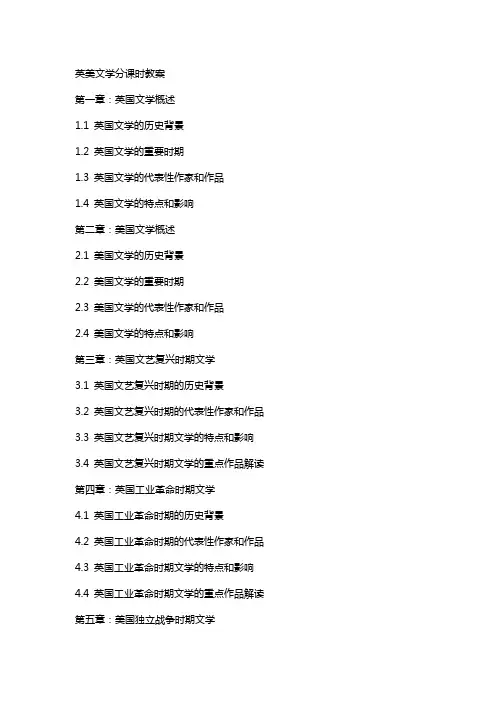
英美文学分课时教案第一章:英国文学概述1.1 英国文学的历史背景1.2 英国文学的重要时期1.3 英国文学的代表性作家和作品1.4 英国文学的特点和影响第二章:美国文学概述2.1 美国文学的历史背景2.2 美国文学的重要时期2.3 美国文学的代表性作家和作品2.4 美国文学的特点和影响第三章:英国文艺复兴时期文学3.1 英国文艺复兴时期的历史背景3.2 英国文艺复兴时期的代表性作家和作品3.3 英国文艺复兴时期文学的特点和影响3.4 英国文艺复兴时期文学的重点作品解读第四章:英国工业革命时期文学4.1 英国工业革命时期的历史背景4.2 英国工业革命时期的代表性作家和作品4.3 英国工业革命时期文学的特点和影响4.4 英国工业革命时期文学的重点作品解读第五章:美国独立战争时期文学5.1 美国独立战争时期的历史背景5.2 美国独立战争时期的代表性作家和作品5.3 美国独立战争时期文学的特点和影响5.4 美国独立战争时期文学的重点作品解读第六章:19世纪英国文学6.1 19世纪英国文学的历史背景6.2 19世纪英国文学的重要时期6.3 19世纪英国文学的代表性作家和作品6.4 19世纪英国文学的特点和影响第七章:19世纪美国文学7.1 19世纪美国文学的历史背景7.2 19世纪美国文学的重要时期7.3 19世纪美国文学的代表性作家和作品7.4 19世纪美国文学的特点和影响第八章:20世纪英国文学8.1 20世纪英国文学的历史背景8.2 20世纪英国文学的重要时期8.3 20世纪英国文学的代表性作家和作品8.4 20世纪英国文学的特点和影响第九章:20世纪美国文学9.1 20世纪美国文学的历史背景9.2 20世纪美国文学的重要时期9.3 20世纪美国文学的代表性作家和作品9.4 20世纪美国文学的特点和影响第十章:英美文学研究的现状与展望10.1 英美文学研究的现状10.2 英美文学研究的趋势和热点10.3 英美文学研究的挑战和机遇10.4 英美文学研究的未来展望第十一章:英国文学的主题与形式11.1 英国文学的常见主题11.2 英国文学的形式与风格11.3 英国文学中的象征与隐喻11.4 英国文学的叙事技巧第十二章:美国文学的主题与形式12.1 美国文学的常见主题12.2 美国文学的形式与风格12.3 美国文学中的象征与隐喻12.4 美国文学的叙事技巧第十三章:英美文学的批评与解读13.1 文学批评的基本概念与方法13.2 英美文学的文本解读技巧13.3 文学批评在英美文学研究中的应用13.4 当代英美文学批评的趋势与争议第十四章:英美文学作品的影视改编14.1 英美文学作品影视改编的历史与现状14.2 影视改编对原著的影响与争议14.3 经典英美文学作品的电影与电视剧解析14.4 学生作品的影视改编练习与评价第十五章:英美文学作品的选择与教学15.1 英美文学作品的教学目标与原则15.2 适合教学的英美文学作品特点15.3 英美文学作品的课程设计与教学方法15.4 教学资源的整合与创新教学实践重点和难点解析本文档为英美文学分课时教案,共包含十五个章节,涵盖了英国和美国文学的历史、时期、作家、作品、主题、形式、批评、解读、影视改编以及教学等多个方面。

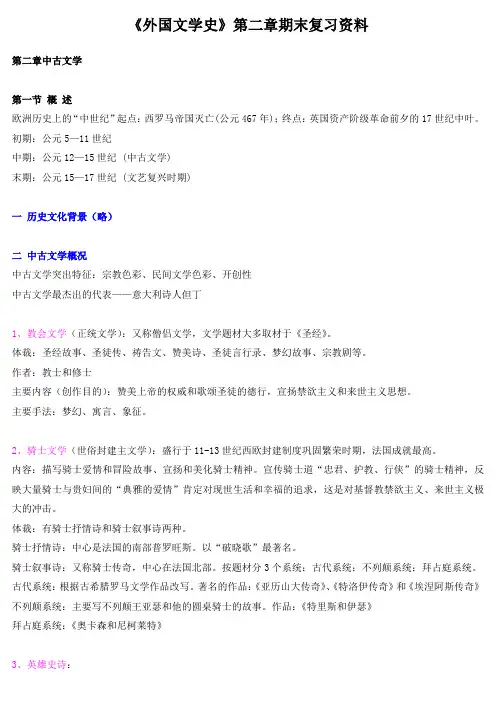
《外国文学史》第二章期末复习资料第二章中古文学第一节概述欧洲历史上的“中世纪”起点:西罗马帝国灭亡(公元467年);终点:英国资产阶级革命前夕的17世纪中叶。
初期:公元5—11世纪中期:公元12—15世纪 (中古文学)末期:公元15—17世纪 (文艺复兴时期)一历史文化背景(略)二中古文学概况中古文学突出特征:宗教色彩、民间文学色彩、开创性中古文学最杰出的代表——意大利诗人但丁1、教会文学(正统文学):又称僧侣文学,文学题材大多取材于《圣经》。
体裁:圣经故事、圣徒传、祷告文、赞美诗、圣徒言行录、梦幻故事、宗教剧等。
作者:教士和修士主要内容(创作目的):赞美上帝的权威和歌颂圣徒的德行,宣扬禁欲主义和来世主义思想。
主要手法:梦幻、寓言、象征。
2、骑士文学(世俗封建主文学):盛行于11-13世纪西欧封建制度巩固繁荣时期,法国成就最高。
内容:描写骑士爱情和冒险故事、宣扬和美化骑士精神。
宣传骑士道“忠君、护教、行侠”的骑士精神,反映大量骑士与贵妇间的“典雅的爱情”肯定对现世生活和幸福的追求,这是对基督教禁欲主义、来世主义极大的冲击。
体裁:有骑士抒情诗和骑士叙事诗两种。
骑士抒情诗:中心是法国的南部普罗旺斯。
以“破晓歌”最著名。
骑士叙事诗:又称骑士传奇,中心在法国北部。
按题材分3个系统:古代系统;不列颠系统;拜占庭系统。
古代系统:根据古希腊罗马文学作品改写。
著名的作品:《亚历山大传奇》、《特洛伊传奇》和《埃涅阿斯传奇》不列颠系统:主要写不列颠王亚瑟和他的圆桌骑士的故事。
作品:《特里斯和伊瑟》拜占庭系统:《奥卡森和尼柯莱特》3、英雄史诗:前期英雄史诗(中世纪初期)日耳曼人:《希尔德布兰特之歌》芬兰:《卡勒瓦拉》(又译《英雄国》)冰岛:《埃达》《萨迦》《贝奥武甫》:上篇《鹿厅》下篇《屠龙》。
日耳曼人盎格鲁·萨克逊人的史诗《贝奥武甫》——流传至今最完整的一部早期英雄史诗。
中心主题:爱国主义、英雄主义、诗中的英雄具有忠君爱国、英勇善战的高尚情操。
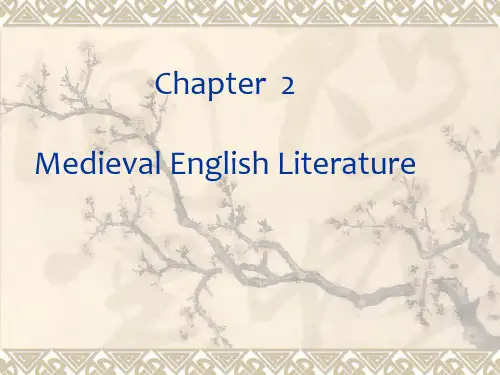
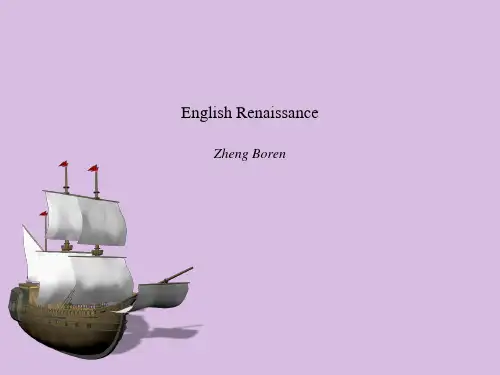
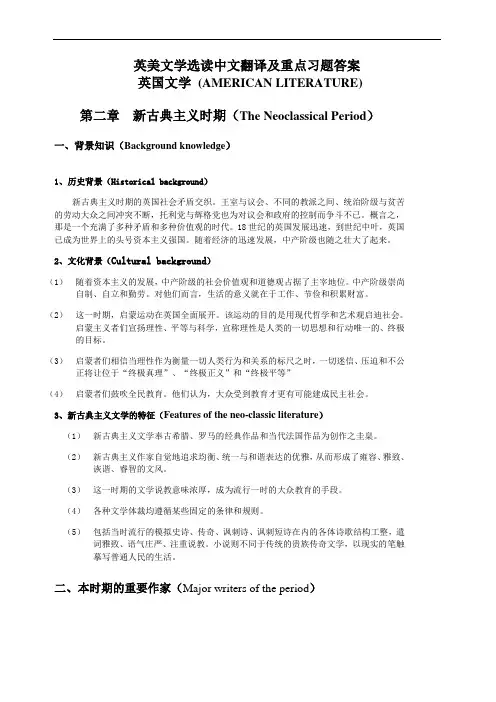
英美文学选读中文翻译及重点习题答案英国文学(AMERICAN LITERATURE) 第二章新古典主义时期(The Neoclassical Period)一、背景知识(Background knowledge)1、历史背景(Historical background)新古典主义时期的英国社会矛盾交织。
王室与议会、不同的教派之间、统治阶级与贫苦的劳动大众之间冲突不断,托利党与辉格党也为对议会和政府的控制而争斗不已。
概言之,那是一个充满了多种矛盾和多种价值观的时代。
18世纪的英国发展迅速,到世纪中叶,英国已成为世界上的头号资本主义强国。
随着经济的迅速发展,中产阶级也随之壮大了起来。
2、文化背景(Cultural background)(1)随着资本主义的发展,中产阶级的社会价值观和道德观占据了主宰地位。
中产阶级崇尚自制、自立和勤劳。
对他们而言,生活的意义就在于工作、节俭和积累财富。
(2)这一时期,启蒙运动在英国全面展开。
该运动的目的是用现代哲学和艺术观启迪社会。
启蒙主义者们宣扬理性、平等与科学,宣称理性是人类的一切思想和行动唯一的、终极的目标。
(3)启蒙者们相信当理性作为衡量一切人类行为和关系的标尺之时,一切迷信、压迫和不公正将让位于“终极真理”、“终极正义”和“终极平等”(4)启蒙者们鼓吹全民教育。
他们认为,大众受到教育才更有可能建成民主社会。
3、新古典主义文学的特征(Features of the neo-classic literature)(1)新古典主义文学奉古希腊、罗马的经典作品和当代法国作品为创作之圭臬。
(2)新古典主义作家自觉地追求均衡、统一与和谐表达的优雅,从而形成了雍容、雅致、诙谐、睿智的文风。
(3)这一时期的文学说教意味浓厚,成为流行一时的大众教育的手段。
(4)各种文学体裁均遵循某些固定的条律和规则。
(5)包括当时流行的模拟史诗、传奇、讽刺诗、讽刺短诗在内的各体诗歌结构工整,遣词雅致、语气庄严、注重说教。
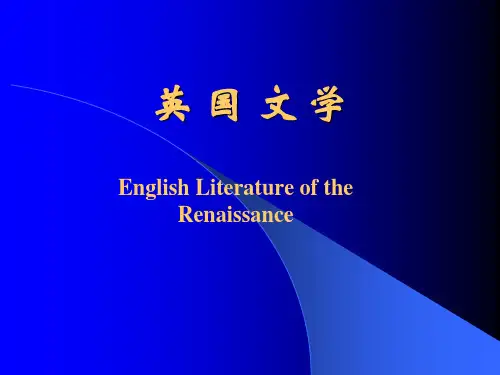
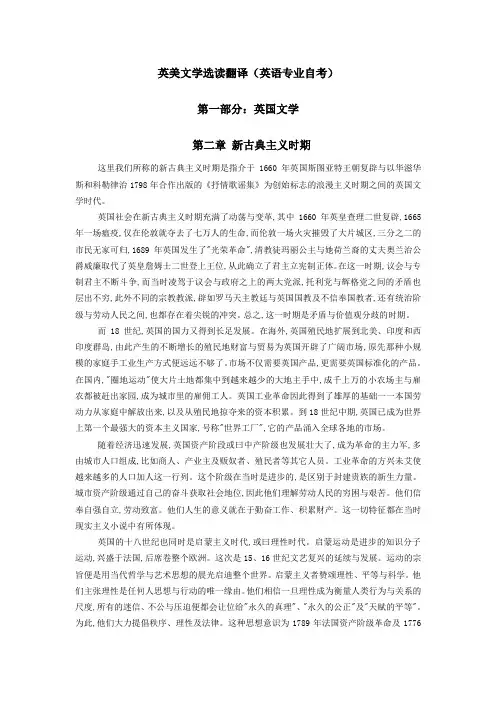
英美文学选读翻译(英语专业自考)第一部分:英国文学第二章新古典主义时期这里我们所称的新古典主义时期是指介于1660年英国斯图亚特王朝复辟与以华滋华斯和科勒律治1798年合作出版的《抒情歌谣集》为创始标志的浪漫主义时期之间的英国文学时代。
英国社会在新古典主义时期充满了动荡与变革,其中1660年英皇查理二世复辟,1665年一场瘟疫,仅在伦敦就夺去了七万人的生命,而伦敦一场火灾摧毁了大片城区,三分之二的市民无家可归,1689年英国发生了"光荣革命",清教徒玛丽公主与她荷兰裔的丈夫奥兰治公爵威廉取代了英皇詹姆士二世登上王位,从此确立了君主立宪制正体。
在这一时期,议会与专制君主不断斗争,而当时凌驾于议会与政府之上的两大党派,托利党与辉格党之间的矛盾也层出不穷,此外不同的宗教教派,辟如罗马天主教廷与英国国教及不信奉国教者,还有统治阶级与劳动人民之间,也都存在着尖锐的冲突。
总之,这一时期是矛盾与价值观分歧的时期。
而18世纪,英国的国力又得到长足发展。
在海外,英国殖民地扩展到北美、印度和西印度群岛,由此产生的不断增长的殖民地财富与贸易为英国开辟了广阔市场,原先那种小规模的家庭手工业生产方式便远远不够了。
市场不仅需要英国产品,更需要英国标准化的产品。
在国内,"圈地运动"使大片土地都集中到越来越少的大地主手中,成千上万的小农场主与雇农都被赶出家园,成为城市里的雇佣工人。
英国工业革命因此得到了雄厚的基础一一本国劳动力从家庭中解放出来,以及从殖民地掠夺来的资本积累。
到18世纪中期,英国已成为世界上第一个最强大的资本主义国家,号称"世界工厂",它的产品涌入全球各地的市场。
随着经济迅速发展,英国资产阶段或曰中产阶级也发展壮大了,成为革命的主力军,多由城市人口组成,比如商人、产业主及贩奴者、殖民者等其它人员。
工业革命的方兴未艾使越来越多的人口加人这一行列。
这个阶级在当时是进步的,是区别于封建贵族的新生力量。
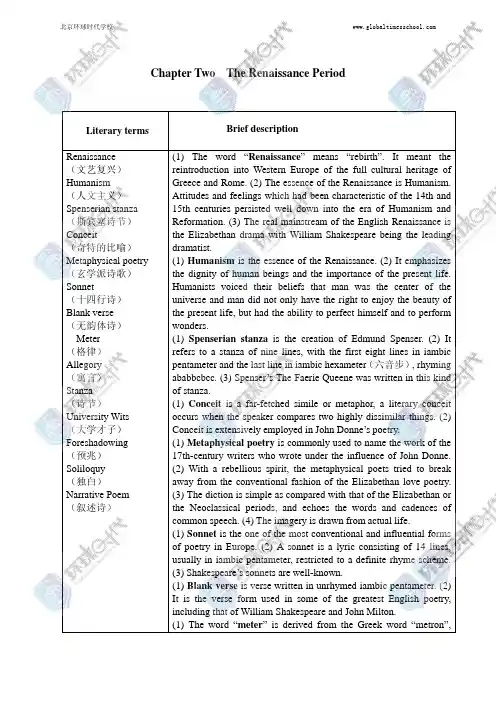
Chapter Two The Renaissance PeriodLiterary termsBrief descriptionRenaissance (文艺复兴) Humanism (人文主义) Spenserian stanza (斯宾塞诗节) Conceit(奇特的比喻) Metaphysical poetry (玄学派诗歌) Sonnet(十四行诗) Blank verse (无韵体诗) Meter (格律) Allegory (寓言) Stanza (诗节)University Wits (大学才子) Foreshadowing (预兆) Soliloquy (独白)Narrative Poem (叙述诗)(1) The word “Renaissance ” means “rebirth”. It meant the reintroduction into Western Europe of the full cultural heritage of Greece and Rome. (2) The essence of the Renaissance is Humanism. Attitudes and feelings which had been characteristic of the 14th and 15th centuries persisted well down into the era of Humanism and Reformation. (3) The real mainstream of the English Renaissance is the Elizabethan drama with William Shakespeare being the leading dramatist.(1) Humanism is the essence of the Renaissance. (2) It emphasizes the dignity of human beings and the importance of the present life. Humanists voiced their beliefs that man was the center of the universe and man did not only have the right to enjoy the beauty of the present life, but had the ability to perfect himself and to perform wonders.(1) Spenserian stanza is the creation of Edmund Spenser. (2) It refers to a stanza of nine lines, with the first eight lines in iambic pentameter and the last line in iambic hexameter (六音步), rhyming ababbcbcc. (3) Spenser’s The Faerie Queene was written in this kind of stanza.(1) Conceit is a far-fetched simile or metaphor, a literary conceit occurs when the speaker compares two highly dissimilar things. (2) Conceit is extensively employed in John Donne’s poetry.(1) Metaphysical poetry is commonly used to name the work of the 17th-century writers who wrote under the influence of John Donne. (2) With a rebellious spirit, the metaphysical poets tried to break away from the conventional fashion of the Elizabethan love poetry. (3) The diction is simple as compared with that of the Elizabethan or the Neoclassical periods, and echoes the words and cadences of common speech. (4) The imagery is drawn from actual life.(1) Sonnet is the one of the most conventional and influential forms of poetry in Europe. (2) A sonnet is a lyric consisting of 14 lines, usually in iambic pentameter, restricted to a definite rhyme scheme. (3) Shakespeare’s sonnets are well-known.(1) Blank verse is verse written in unrhymed iambic pentameter. (2) It is the verse form used in some of the greatest English poetry, including that of William Shakespeare and John Milton.(1) The word “meter ” is derived from the Greek word “metron”,meaning “measure”. (2) In English when applied to poetry, it refers to the regular pattern of stressed and unstressed syllables. (3) The analysis of the meter is called scansion(格律分析).(1) Allegory is a story told to explain or teach something, especiallya long and complicated story with an underlying meaning different from the surface meaning of the story itself. (2) Allegorical novels use extended metaphors to convey moral meanings or attack certain social evils. Characters in these novels often stand for different values such as virtue and vice. (3) Bunyan's The Pilgrim's Progress,Golding's Lord of the Flies and Melville’s Moby Dick are three examples of this kind.(1)Stanza is a group of lines of poetry, usually four or more, arranged according to a fixed plan. (2) The stanza is the unit of structure in a poem and poets do not vary the unit within a poem.(1) University Wits refer to a group of scholars during the Elizabethan Age who graduated from either Oxford or Cambridge. They came to London with the ambition to become professional writers. Some of them later became famous poets and playwrights. They were called “university wits”. (2) Thomas Greene, ThomasKyd, John Lily and Christopher Marlowe were among them. (3) They paved the way, to some degree, for the coming of Shakespeare.(1) Foreshadowing, in drama, means a method used to build suspense by providing hints of what is to come. (2) In Shakespeare’s “Romeo and Juliet”, Romeo’s expression of fear in Act 1, Scene 4 foreshadows the catastrophe to come: I fear too early; for my mind misgives; Some consequence yet hanging in the stars…(1) Soliloquy, in drama, means a moment when a character is alone and speaks his or her thoughts aloud. (2) In the line “To be, or not to be, that is the question”, which begins the famous soliloquy from Act 3, scene 1 of Shakespeare’s “Hamlet”. In this soliloquy Hamlet questions whether or not life is worth living, and speaks of the reasons why he does not end his life.(1) A Narrative Poem refers to a poem that tells a story. (2) It may consist of a series of incidents, as in Homer’s “The Iliad” and “The Odysseus”, and John Milton’s “Paradise Lost”.Name of the WriterWorks Brief descriptionPhilip Sidney (1554-1586) (菲利普·锡尼爵士) (1) He stands for the spirit of the Elizabethan Age. (2) In many ways he represents the Renaissance ideal of “the complete man”.Arcadia 《阿卡狄亚》 Astrophel and Stella 《阿斯特罗菲尔与斯特拉》Defense of Poetry 《为诗歌辩护》 (1) Arcadia is a prose romance filled with lyrics. (2) It is regarded as a forerunner of the modern world. Edmund Spenser (1552-1599)(埃德蒙·斯宾塞) (1) He is acclaimed as “the poets’ poet” in English literature. (2) His poetry is noted for such qualities as a perfect melody; a rare sense of beauty; a splendid imagination, a lofty moral purity and seriousness, and a dedicated idealism. (3) He created the Spenserian stanza. (4) His masterpiece is the Faerie Queene.The Faerie Queene 《仙后》 The Shepherd Calendar 《牧羊人日记》 (1) The Faerie Queene is Spenser’s masterpiece, a great poem of its age. (2) The fairy queen in the poem stands for both the Queen Elizabeth and glory. (3) In the poem Spenser speaks of 12 virtues of a perfect gentleman. (4) This allegorical poem is distinguished for its rich content and exquisite style. (5) The poem is written in the form of the Spenserian Stanza. (6) The Red-cross Knight in the poem represents the Church of England. The Shepheardes Calender records and expresses the poet’s laments over the loss of Rosalind. Thomas More (1478-1535)(托马斯·莫尔) (1) He is the greatest of the English humanists. (2) He authored “Utopia”Utopia 《乌托邦》 (1) Utopia describes an ideal commonwealth in which property is shared in common and poverty does not exist. (2) The name “Utopia” is derived from two Greek words meaning “no place”. Christopher Marlowe (1564---1593)(克里斯托弗·马洛) (1) As the most gifted of the “University Wits”, Marlowe authored six plays Tamburlaine 《铁木耳大帝》 (1) Tamburlaine is a play about an ambitious and cruel Tartar conqueror in the fourteenth century who rose from a shepherd to an overpowering king. (2) It voiced the supreme desire of the man of the Renaissance for infinite power and authority.within his short lifetime. (2) The most important ones are: Tamburlaine , Dr. Faustus , The Jew of Malta . (3) Marlowe’s greatest literaryachievement lies in that he perfected the blank verse and made it the principal medium of English drama. (4) Marlowe’s second achievement consists in his creation of theRenaissance hero for English drama. Such hero is always individualistic and fullof ambition, facingbravely the challenge from both gods andmen. Such a heroembodies Marlowe’s humanistic ideal of human dignity and capacity. With the endless aspiration for power, knowledge, and glory, the hero embodies the true Renaissance spirit.Dr. Faustus 《浮士德的悲剧》The Jew of Malta 《马耳他的犹太人》 The Passionate Shepherd to His Love 《多情的牧羊人致情人》 (1) Dr. Faustus is a play based on the German legend of a magician aspiring forknowledge and finally meeting his tragic end as a result of selling his soul to the Devil. (2) It celebrates the human passion for knowledge and happiness. (3) It alsoreveals man’s frustration in realizing the high aspirations in a hostile moral order. (4) And the confinement to time is the cruelest fact of man’s condition.The Jew of Malta expresses man’s desirefor wealth.(1) “The Passionate Shepherd to HisLove” is considered to be one of the most beautiful lyrics in English literature. (2) It is composed in the tradition of the pastoral tradition, in which the shepherdenjoys an ideal country life, cherishing a pastoral and pure affection for his love. (3) Strong emotion is conveyed through thebeauty of nature when lovers are not disturbed by worldly concern. (4) The rhyme scheme of the poem is aabb. William Shakespeare (1564-1616)(威廉·莎士比亚) (1) He is the greatest of all Elizabethan dramatists. (2) His literary career falls into four periods. He wrote 37 plays and 154 sonnets. (3) His sonnets represent the finest poetic craftsmanship of Henry VI 《亨利六世》 Richard III 《理查德三世》 Henry IV 《亨利四世》Henry V 《亨利五世》Henry VIII 《亨利八世》A Midsummer Night's Dream(1) Hamlet is the greatest tragedy of Shakespeare’s. (2) Hamlet, the melancholic scholar-prince, faces the dilemma between action and mind. (3) His famous monologue is “To be or not to be”.(1) Othello is a tragedy of humanism. (2) Hisinner weakness is made use of by the outside evilforce.(1) Macbeth is a tragedy of all ambitiousElizabethan poetry. (4) The themes of his sonnets are about love, friendship, the destructive effects of time, the quickness of physical decay, and the loss of8 beauty, vigor, and love. 《仲夏夜之梦》 The Merchant of Venice 《威尼斯商人》 As You Like it 《皆大欢喜》 Twelfth Night 《第十二夜》 Hamlet 《哈姆雷特》Othello 《奥赛罗》 King Lear 《李尔王》 Mecbeth 《麦克白》 Romeo and Juliet 《罗密欧与朱丽叶》 The Tempest 《暴风雨》Sonnet 18adventurers who become the prey of theirambition. (2) Macbeth’s lust for power stirs ups his ambition and drives him to incessant crimes.(1) King Lear is based on an old British legend. (2) The old King Lear is a self-willed ruler who suffers from treachery and infidelity on account of his irresponsibility and vanity. (3) The climax of the play is Act III, Scene 4 where images of such animals as bear, wolf, fox, dog, monkey, rat and worm stand out. These images reflect the jungle law of the age of primitive accumulation. (4) In King Lear , Shakespeare has not only made a profound analysis of the social crisis in which the evils can be seen everywhere, but also criticized the bourgeois egoism. (5) Shakespeare points out that a king or ruler must be responsible to his people. (1) The Merchant of Venice is a play eulogizing the friendship between Antonio and Bassanio, idealizing Portia as a heroine of great beauty, wit and loyalty, and exposing the insatiable greed and brutality of the Jew represented by Shylock. (2) But people today tend to regard the play as a satire of the Christian’s hypocrisy and their false standards, their cunning ways of pursuing worldliness and their unreasoning prejudice against Jews. (3) The allusion “pound of flesh” comes from this comedy. (1) Sonnet 18 is one of Shakespeare’s most beautiful sonnets. In the poem he has a profound meditation on the destructive power of time and the eternal beauty brought forth by poetry to the one he loves. A nice summer’s day is usually transient, but the beauty in poetry can last for ever. Thus Shakespeare has a faith in the permanence of poetry. (2) The rhyme of the poem is abab cdcd efef gg. Francis Bacon(1) The Advancement of Learning is a(1561-1626)(弗兰西斯·培根) (1) He is a philosopher, a scientist and the first English essayist. (2) He lays the foundation for modern science with his insistence on scientific way of thinking and fresh observation rather than authority as a basis for obtaining knowledge. (3) He is best known for hisEssays that is the first example of that genrein English literature.Essays 《培根论说文集》 Of Studies 《谈读书》 The Advancement of Learning 《论学问的进步》Novum Organum (TheNew Instrument) 《论新工具》great tract on education. (2) Here Bacon highly praises knowledge, refuting the objections to learning and outlining the problems with which his plan is to deal. (3) Also he answers the charge that learning is against religion.(1) Novum Organum (The New Instrument ) is a successful treatise written inLatin on methodology. (2) The argument is forthe use of inductive method of reasoning inscientific study.(1) Of Studies is the most popular ofBacon’s essays. (2) It analyzes what studies chiefly serve for, the different ways adopted by different people to pursue studies, and how studies exert influence over human character. (3) Forceful and persuasive, compact and precise, the essay reveals to us Bacon’s mature attitude towards learning.John Donne (1572-1631)(约翰·邓恩) (1) He is the leading figure of the “metaphysical school”. (2) The most striking feature of Donne’s poetry is his frequent use of conceit. (3) He is a religious poet obsessed with death. (4) The Songs and Sonnets is probably his best-known lyrics. Love is the basic theme. Donne holds that the nature of love is the union of soul and body."The Sun Rising" 《升起的太阳》 The Holy Sonnets 《神圣体十四行诗》 The Songs and Sonnets 《歌谣与十四行诗》 "Death, Be Not Proud" 《死亡,你别骄傲》 The Flea 《跳蚤之歌》 A Valediction: Forbidding Mourning 《分别:莫忧伤》 (1) The Songs and Sonnets is probably his best-known lyrics. (2) Love is the basic theme. John Donne holds that the nature of love is the union of soul and body. (1) In A Valediction: Forbidding Mourning John Donne resents too much display of emotion when two lovers part. (2) In this poem we are familiarized with John Donne’s famous conceit: the two lovers (he and his wife) are likened to the two points of a compass. The wife stays at home. She is the fixed foot and the husband “roams” around, but never deviates from the center. (3) In a word, John Donne seems to emphasize the importance of Platonic love. John Milton Paradise Lost (1) Paradise Lost is the greatest of John(1608-1674)(约翰·弥尔顿) (1) As a real revolutionary, a master poet and a great prose writer, Milton holds an important place in the history of English literature. (2) He produced three epics: Paradise Lost, Paradise Regained and Samson Agonistes.《失乐园》Paradise Regained 《复乐园》Samson Agonistes 《力士参孙》 Milton’s epics. (2) It is the only generally acknowledged epic in English literature since Beowulf. (3) The story is taken from the Bible. The theme of the epic is man’s disobedience and the loss of Paradise, with its prime cause ---- Satan who rebels against God’s authority and tyranny.Paradise Regained is a long narrative poem telling how man, in the person of Christ, withstands the tempter and is established once more in the divine favor.(1) Samson Agonistes is the most perfect example of the verse drama after the Greek style in English. (2) In this epic Milton presents to us a picture of how Samson, the Israel’s mighty champion, brings destruction down upon the enemy at the cost of his own life. (3) The whole poem strongly suggests Milton’s passionate longing like Samson’s that he too could bring destruction down upon the enemy at the cost of his own life. In this sense, Samson is Milton.John Bunyan (1628-1688)(约翰·班扬)(1) He is a religious novelist whose style was modeled after that of the English Bible. (2) His language is concrete and vivid. (3) His masterpiece, The Pilgrim’s Progress, is the most successful religious allegory. The Pilgrim's Progress 《天路历程》 (1) The Pilgrim’s Progress is John Bunyan’s masterpiece. It is the most successful religious allegory. (2) It tells of the experience of a devout Christian the Pilgrim with a neighbor named Faithful in a world full of vice and wickedness. (3) It is a prose allegory depicting the pilgrimage of a human soul in search of salvation. (4) The novel is not only about something spiritual but also bears much relevance to the time. (5) Its predominant metaphor is the metaphor of life as a journey. (6) The most famous scene in the novel if Vanity Fair.。
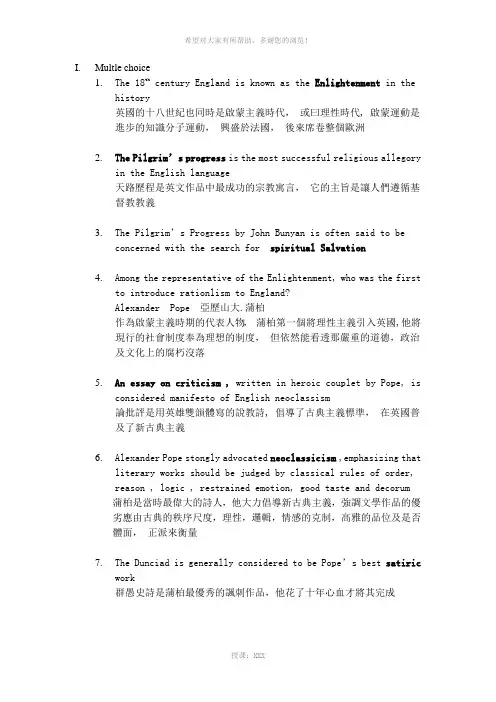
I.Multle choice1.The 18th century England is known as the Enlightenment in thehistory英國的十八世紀也同時是啟蒙主義時代,或曰理性時代, 啟蒙運動是進步的知識分子運動,興盛於法國,後來席卷整個歐洲2.The Pilgrim’s progress is the most successful religious allegoryin the English language天路歷程是英文作品中最成功的宗教寓言,它的主旨是讓人們遵循基督教教義3.The Pilgrim’s Progress by John Bunyan is often said to beconcerned with the search for spiritual Salvation4.Among the representative of the Enlightenment, who was the firstto introduce rationlism to England?Alexander Pope 亞歷山大.蒲柏作為啟蒙主義時期的代表人物,蒲柏第一個將理性主義引入英國,他將現行的社會制度奉為理想的制度,但依然能看透那嚴重的道德,政治及文化上的腐朽沒落5.An essay on criticism , written in heroic couplet by Pope, isconsidered manifesto of English neoclassism論批評是用英雄雙韻體寫的說教詩, 倡導了古典主義標準,在英國普及了新古典主義6.Alexander Pope stongly advocated neoclassicism,emphasizing thatliterary works should be judged by classical rules of order,reason , logic , restrained emotion, good taste and decorum蒲柏是當時最偉大的詩人,他大力倡導新古典主義,強調文學作品的優劣應由古典的秩序尺度,理性,邏輯,情感的克制,高雅的品位及是否體面,正派來衡量7.The Dunciad is generally considered to be Pope’s best satiricwork群愚史詩是蒲柏最優秀的諷刺作品,他花了十年心血才將其完成8.Daniel Defore describes as a typical Englishmiddle-class man of the eighteen century, the very prototype of the empire builder or the pioneer colonistMoll Flanders 莫爾。
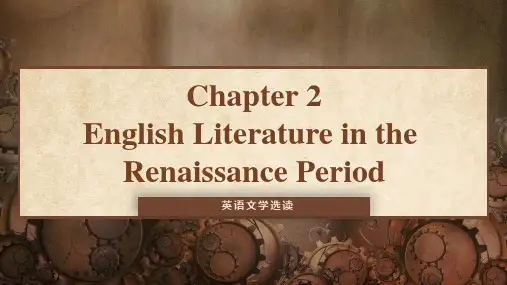
专八人文知识:美国文学简史(二)Chapter 2 American RomanticismSection 1 Early Romantic PeriodWhat is Romanticism?l An approach from ancient Greek: Platol A literary trend: 18c in Britain (1798~1832)l Schlegel Bros.I. Preview: Characteristics of romanticism1. subjectivity(1) feeling and emotions, finding truth(2) emphasis on imagination(3) emphasis on individualism –personal freedom, no hero worship, natural goodness of human beings2. back to medieval, esp medieval folk literature(1) unrestrained by classical rules(2) full of imagination(3) colloquial language(4) freedom of imagination(5) genuine in feelings: answer their call for classics3. back to naturenature is “breathing living thing” (Rousseau)II. American Romanticism1. Background(1) Political background and economic development(2) Romantic movement in European countriesDerivative –foreign influence2. features(1) American romanticism was in essence the expression of “a real new experience and contained “an alien quality” for the simple reason that “the spirit of the place” was radically new and alien.(2) There is American Puritanism as a cultural heritage to consider. American romantic authors tended more to moralize. Many American romantic writings intended to edify more than they entertained.(3) The “newness” of Americans as a nation is in connection with American Romanticism.(4) As a logical result of the foreign and native factors at work, American romanticism was both imitative and independent.III. Washington Irving1. several names attached to Irving(1) first American writer(2) the messenger sent from the new world to the old world(3) father of American literature2. life3. works(1) A History of New York from the Beginning of the World to the End of the Dutch Dynasty(2) The Sketch Book of Geoffrey Crayon, Gent. (He won a measure of international recognition with the publ ication of this.)(3) The History of the Life and Voyages of Christopher Columbus(4) A Chronicle of the Conquest of Granada(5) The Alhambra4. Literary career: two parts(1) 1809~1832a. Subjects are either English or Europeanb. Conservative love for the antique(2) 1832~1859: back to US5. style –beautiful(1) gentility, urbanity, pleasantness(2) avoiding moralizing –amusing and entertaining(3) enveloping stories in an atmosphere(4) vivid and true character s(5) humour –smiling while reading(6) musical languageIV. James Fenimore Cooper1. life2. works(1) Precaution (1820, his first novel, imitating Austen’s Pride and Prejudice)(2) The Spy (his second novel and great success)(3) Leatherstocking Tales (his masterpiece, a series of five novels)The Deerslayer, The Last of the Mohicans, The Pathfinder, The Pioneer, The Prairie3. point of viewthe theme of wilderness vs. civilization, freedom vs. law, order vs. change, aristocrat vs. democrat, natural ri ghts vs. legal rights4. style(1) highly imaginative(2) good at inventing tales(3) good at landscape description(4) conservative(5) character ization wooden and lacking in probability(6) language and use of dialect not authentic5. literary achievementsHe created a myth about the formative period of the American nation. If the history of the United States is, in a sense, the process of the American settlers exploring and pushing the American frontier forever westward, t hen Cooper’s Leatherstocking Tales effectively approximates the American national experience of adventure into t he West. He turned the west and frontier as a useable past and he helped to introduce western tradition to Am erican literature.。
(word完整版)英美文学史复习笔记编辑整理:尊敬的读者朋友们:这里是精品文档编辑中心,本文档内容是由我和我的同事精心编辑整理后发布的,发布之前我们对文中内容进行仔细校对,但是难免会有疏漏的地方,但是任然希望((word完整版)英美文学史复习笔记)的内容能够给您的工作和学习带来便利。
同时也真诚的希望收到您的建议和反馈,这将是我们进步的源泉,前进的动力。
本文可编辑可修改,如果觉得对您有帮助请收藏以便随时查阅,最后祝您生活愉快业绩进步,以下为(word完整版)英美文学史复习笔记的全部内容。
Chapter 1 Old and Medieval English Literature(450—1066—1340)1.Beowulf: a typical example of Old English poetry is regarded as the national epic of the Anglo—Saxons. It is an example of the mingling of nature myths and heroic legends.2.Romance:①It uses narrative verse or prose to sing knightly adventures or other heroic deeds is a popular literary form in the medieval period。
②It has developed the characteristic medieval motifs of the quest, the test, the meeting with the evil giant and the encounter with the beautiful beloved.③The hero is usually the knight, who sets out on a journey to accomplish some missions。